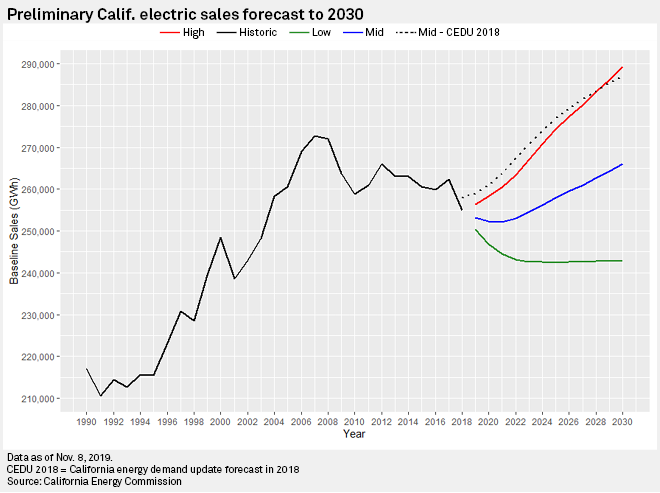
An electric car plugged in to a public charging station in San Francisco. |
After a decade of soft to diminishing sales of electricity, U.S. utilities could see a sustained rebound in the 2020s.
Or not.
Sales in the next decade will pivot largely on two distinct energy transition wild cards: the rollout of electric vehicles, which boost demand for grid power, and continued growth in rooftop solar, which reduces it. Economic output will also play a large role, as will the spread of energy efficiency measures, which curb overall electricity demand, and the electrification of other sectors of the economy, which could expand it dramatically.
For investor-owned utilities in select states, there is the added uncertainty of customer migration to local government-run retail power agencies known as community choice aggregators, or CCAs.
Diverging scenarios in California, the leading U.S. market for electric vehicles and distributed solar arrays, highlight the planning challenges that, to varying degrees, will affect the power sector nationwide over the next decade.
The California Energy Commission's latest draft integrated energy policy report, released in November, describes a trio of possible paths that range from reinvigorated growth of retail electricity sales in the 2020s to ongoing deterioration. Up for approval in January, the agency's assessment will help guide the state's decisions on how to provide grid reliability and expand infrastructure as it embarks on the transition to a zero-carbon economy by midcentury.
Dip or jump
Investor-owned utilities Pacific Gas and Electric Co., Southern California Edison Co. and San Diego Gas & Electric Co., along with the state's other electric utilities and CCAs, could see combined sales dip under 245,000 GWh in the early 2020s, from roughly 255,000 GWh in 2018, or jump to nearly 290,000 GWh by 2030, according to the preliminary analysis.
Uncertainties around the adoption of electric vehicles and behind-the-meter solar account for much of the discrepancy.
Under the agency's most aggressive forecast, California's fleet of light-duty plug-in electric vehicles could surge to 5.6 million by 2030, up from about 500,000 entering 2019. Even the lowest forecast sees plug-in EVs reaching 2.7 million by that time. Total transportation electricity demand, under 5,000 GWh in 2019, could more than double to over 10,000 GWh by 2030 or could surpass 20,000 GWh, the commission's report said.
Some regulators and utilities believe that transportation energy demand could go even higher.
"We talk a lot about how transportation is going to be this big new load, and we're looking out to 2030 and … it looks like the long-term managed forecasts are pretty low," California Energy Commission member Andrew McAllister said during a Dec. 2 meeting on the report.
What is more, the report does not represent the full spectrum of possible EV adoption scenarios in the state. Southern California Edison, for instance, has called for at least 7 million electric cars on California's roads by 2030, exceeding the commission's most aggressive outlook.

Solar uncertainties
California's solar mandate for new homes, adopted at the end of 2018 and set to take effect in 2020, has lowered the agency's overall electric sales forecast. Depending on new home construction and the broader strength of California's economy, the agency's expectations for total installed behind-the-meter solar capacity in 2030 range between 19,900 MW and 26,700 MW, up from 8,100 MW entering 2019.
A midlevel outlook of 23,300 MW of distributed solar in 2030 shows high single-digit to low double-digit annual growth rates for residential and commercial solar segments across the service territories of the three large investor-owned utilities as well as for municipal utilities Los Angeles Department of Water and Power and Sacramento Municipal Utility District.
But after seeing the installation in December of its millionth solar rooftop, California faces uncertainties about the pace of future distributed solar installations, especially in the commercial solar market, which retreated across California in the first three quarters of 2019 even as home solar installations rose.
Nam Nguyen, executive vice president of commercial solar at California-based SunPower Corp. blamed the state's time-of-use rate reform for the commercial market slowdown, saying it made rooftop solar "less economical" for some businesses. Coupled with the slower-than-expected spread of community solar arrays, the reform "has presented growth challenges," Nguyen said in an email.
SunPower expects the commercial solar market to continue its decline in 2020. And despite the state's new home solar requirement, the residential solar market faces a major challenge in 2022, when federal tax credits zero-out for individual tax filers, down from 30% of project cost in 2019.
Rising retail competition
Additional pressure on retail electricity sales by California's investor-owned utilities comes from community choice aggregators. While nearly 8% of investor-owned utilities' demand was lost to on-site solar by 2019, according to California Public Utilities Commission data, CCAs had seized nearly a quarter of regulated load, a level that regulators have cautioned could rise to as much as 80% by the mid-2020s.
Such uncertainties are not limited to California. Improving economics are driving rooftop solar demand in smaller markets such as Iowa, New Mexico and Wyoming, while CCAs are eating into investor-owned utility sales in Massachusetts, Illinois, Ohio, New York, New Jersey and Rhode Island. Electric vehicles could reach price parity with their petroleum-powered counterparts by 2024 as lithium-ion battery prices plummet and global automakers introduce new models, potentially sparking a nationwide sales surge.
Overall, the U.S. Energy Information Administration's latest short-term outlook for U.S. retail electric sales sees a slight decline in 2020 and modest, less-than-1% annual increases, on average, through midcentury. But how that ultimately unfolds will depend largely on Americans' embrace of electric vehicles and rooftop solar.



